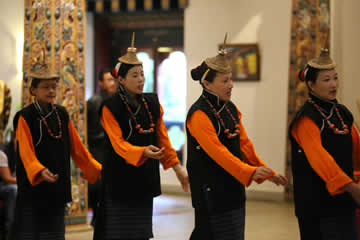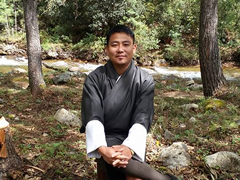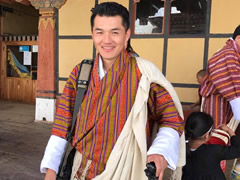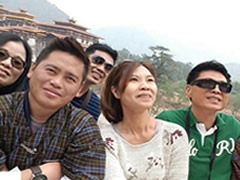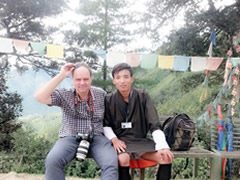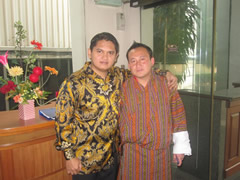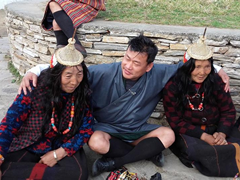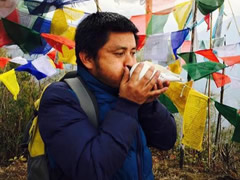Buddha
Buddha is a Pali word which means the “awakened one “. They are also known as sangay which means one who is purified from emotional defilements. To the laymen, Buddha is only referred to Buddha Shakayamuni but in actually there are uncountable numbers of Buddha who have come in the past and yet to come.
Gautama Buddha was the son of King Sakya Sudhodana and Queen Maya. According to the legend, Queen Maya first had a dream of a beautiful white elephant coming down into her womb and this was interpreted as a sign that the Buddha was about to born. When her time came, Queen Maya went into the garden and gave painless birth at a village called Lumbini to the bodhisattva. He immediately walked, spoke and make seven steps and was received by Brahma. Five days after his birth, the young prince received the name of Siddhartha. After seven days queen mother died and he was taken care by her sister.
Wanting his son to be a universal monarch, the king surrounded the place with all entertainment items, Musicians so that he doesn’t get attached with age, sickness and death. The most beautiful prince Yasodhara was found for his bride and they got married when he was at the age of 16. But one day when Siddhartha was walking on the street, he came to know about the age, sickness and death. Then he opened his heart to his father and said, “ Everything in the world is impermanent”. Let me go off alone like a religious beggar.
Grief- stricken at the idea of losing his son , the king doubled the guard around the walls and increased the pleasure ad distractions within. At this point, Yashodhara bore him a son whom he called Rahula (meaning chain or fetter), a name that indicated Gautama’s sense of dissatisfaction with his life of luxury. Luxury life cannot stop him of thinking about the impermanence and so he decided to run away.
His mind made up, he awoke one night and casting one last look at his wife and child, mounted his horse Kataka and rode off accompanied by his equerry Chandaka. Buddha studied doctrine for many years and finally made his way to deer park. He sat beneath the Bodhi tree of wisdom and swore to die before arising without the wisdom he sought.
Mara, the demon got fearful of Gautama’s power and so sent his three beautiful daughters to distract him. When that failed, Mara sent an army of devils to destroy him. Finally Mara attacked Gautama with terrible weapon capable of cleaving a mountain but failed to attack him.
So Buddha attained his first enlightenment at Bodhgaya and made her first teaching at Sarnath. Every fourth day of the sixth month in the Bhutanese calendar is observed as the First Sermon of Lord Buddha, formally known as Drukpa Tshe Zhi. Among the many great deeds of the historical Buddha Shakyamuni, the turning of the Wheel of Dharma at Deer Park in Sarnath is considered the most significant.
The Buddha died of old age, when he was eighty years old at place called Kushinagar. The death was triggered by his body reaction to a dish of wild mushroom. He died peacefully and mindfully. The last meal offered to the Buddha was prepared by Cunda.
Teachings of Buddha
Buddhist philosophy strongly highlights that the world is ever changing and transient in nature so nothing is permanent and eternal. Along with this, the entire world is soulless. Sorrows are part of human existence and life. All human beings have originated from the planet earth and then they bear children for the continuity of life. The basic principles of Buddhism are impermanence, reincarnation and karma.
Based on Buddhism is a teaching of Gautama Buddha. Teachings of Gautama Buddha are the principles of life that had been given by him after attaining the enlightenment. The teachings on the four noble truths are among the very first of many teachings that Shakyamuni Buddha gave in Sarnath (near Benares or Varanasi in North-East India), seven weeks after attaining enlightenment in Bodhgaya.
The four noble truths are as follows:
- The truth of Suffering: Life is full of sufferings and everyone suffers. Birth, old age, sickness and death all involve sufferings.
- The cause of Suffering: The main cause of suffering is our endless desire. Self, greed, desire and ignorance.
- The end of suffering: The only way to end our suffering is to remove desire at its root. So if we can change our own mind, we can also eliminate suffering.
- The path to end our suffering: If we can control our body and mind in a way that we help others instead of doing them harm, and generating wisdom in our own mind, we can end our suffering and problems. The Buddha summarized the correct attitude and actions in the Eight-fold Noble Path.
The eight fold paths are:
- Right View
- Right thought
- Right Speech
- Right Behavior
- Right Livelihood
- Right Effort
- Right Mindfulness
- Right Concentration
In Mahayana Buddhism, it is believed that there are exactly 1000 Buddha’s who will or already have attained enlightenment. In the scriptures there are five groups of Buddha’s namely:
- Buddha’s of the three times
- Primordial Buddha
- The 5 Dhyani or Meditation Buddha’s
- The 1000 Buddha’s
- The 35 Buddha of forgiveness
The different kind of Buddhas can be identified from their different body colors, hand gestures and symbols.
- 1. Buddha’s of the three times
Buddhas of three times means the Buddha of past, present and future. The Buddha of the three times can be seen in Kurje Lhakhang or Tangbi Lhakhang.
- Buddha of the past: Dipankara / Marme Dze
- Buddha of the present: Buddha Shakyamuni
- Buddha of the future: Maitreya / Jowo Jampa.
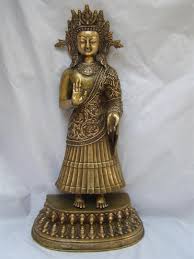 |
Buddha of Past: Dipankara / Marme Dze Buddha Dipankara is said to have lived one hundred thousand years ago and is most popular in Sri Lanka and other maritime cultures. He is depicted in the same manner as the other Buddha’s, in a monk’s robe. His left hand makes dana mudra gesture which symbolizes boon granting while his right hand makes the Abhaya mudra which symbolizes protection and fearlessness. |
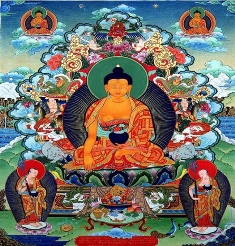 |
Buddha of the present: Buddha Shakyamuni The present Buddha Shakayamuni is also referred to as Sangay , Gautama Buddha. The life story of Buddha is one that we are familiar with. He was initially a prince Siddharta of Lumbini before he renounced everything in search of meaning of life. He attained enlightenment in Bodh Gaya under a Bodhi tree. He is also depicted in a monk’s robe. Buddha’s right hand is in a Bhumispara Mudra, His figure slightly touching the ground with his Palm facing inward which symbolizes victory over demons and unwavering commitment. His right hand comes in other gestures as well. His left hand holds a begging bowl representing his austere and humble lifestyle. Begging for contentment. Satisfied for what we have. |
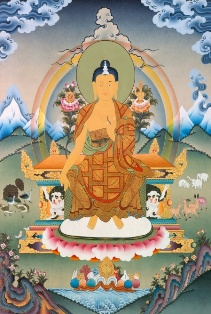 |
Buddha of the future: Maitreya / Jowo Jampa According to Buddhist tradition, Jowo Jampa or Maitreya is a bodhisattva who will appear on Earth in the future, achieve complete enlightenment, and teach the pure dharma. According to scriptures, Maitreya will be a successor to the present Buddha, Gautama Buddha (also known Shakyamuni Buddha). His unusual sitting pose ( Bhadrasana Position ) indicates his descent from heaven as the next Buddha of future. The hand gesture of Maiterya may vary. There are two lotus flowers, one on his left shoulder supporting a Vessel and another on his right Shoulder supporting a wheel. (Chakra). The most distinguishing feature of Buddha Maiterya is the white stupa in his hair. Jowo jampa is considered as both Buddha and a Bodhisattva hence he is adorned with silk garments and jeweled crown. |
Primordial Buddha
The primordial Buddha is also known as Adi- Buddha, Samantabadra or Kuntuzangpo. He is considered to be the very first Buddha.
Adibuddha is blue in color and naked without any attire. He is depicted in union with kuntuzangmo ( Yabyum pose).
The Five meditation or Dhyani Buddha
The five meditation buddhas are: Mitrugpa ( blue), Rinchen Jungney ( Yellow ), Nampar Namze ( white), Yodpame ( Red) and Donyen Dondrup ( Green).
The five different buddhas represent five different wisdoms against the five poisons.
The 1000 Buddhas
The painting of thousand Buddha’s can be seen at Tamzhing and Jampay Lhakhang in Bumthang.
The Thirty Five Buddha’s of Confessions / Forgiveness
The Thirty Five Buddha’s of Confessions / Forgiveness are the Buddha’s to whom we can confess our wrong thoughts and actions and seek forgiveness.
The painting of the thirty five Buddha’s of confession can be seen in Jampay Lhakhang.


